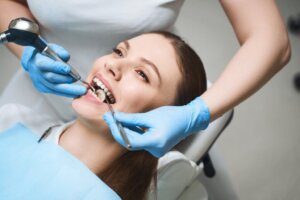The Relationship Between Cavities and Medication


Escrito y verificado por la odontóloga Vanesa Evangelina Buffa
It seems a contradiction, but some medications can promote the production of cavities. This is particularly relevant in children, who are more exposed to the consumption of sweetened medicines. However, in adults with chronic pathologies, this situation must also be considered. Keep reading to discover the link between cavities and medication.
In addition to sugar content, medications associated with cavities often alter the pH of saliva and the amount of saliva production. All drugs are capable of causing side effects. And the mouth isn’t exempt from them.
That’s why it’s worth clarifying that we must always consume active ingredients prescribed by a health professional. In the same way, we must acquire this medication in pharmaceutical premises authorized for this purpose.
What’s the link between cavities and medication?
Drugs have characteristics that are specific to the active principle and others that depend on the excipients. The latter are additives that the companies add to ensure the formula is stable, pleasant to the taste, and able to be preserved, as well as improving its absorption or speeding up its action.
Taking this into account, we could say that there are three main issues behind the medications that are most associated with cavities:
- The sugar content. Especially sucrose and fructose
- Adverse effects that alter saliva production
- The pH or acidity of the medication
Sugars in children’s medicine
Medicine designed for children usually contain high concentrations of sugar. This composition favors the production of cavities.
The cariogenic potential of the sucrose and fructose added to the formula is a substrate for the bacteria in the mouth to metabolize it. This then leads to the demineralization of the enamel.
In medication for adults, it isn’t so common to find high concentrations of sugar. However, it doesn’t hurt to check the composition on the label. This recommendation becomes important for people who take active ingredients chronically or who have a tendency towards cavities due to the characteristics of their mouth.
Xerostomia

The concept of “xerostomia” is that of a dry mouth. It’s a condition in which there’s less saliva production, which conditions the humidity inside the mouth.
Statistical data shows that xerostomia is one of the most frequent oral adverse effects in people who take medication. And, although active principles that generate this effect are recognized, the current situation of patients with multiple pathologies complicates the detection of the origin, since many patients ingest 3, 4 and even 5 pills a day.
Saliva is a protective fluid for the teeth. It cleans its surface and has an antibacterial capacity that limits the proliferation of harmful microorganisms in the mouth. Therefore, its reduction is associated with the development of caries.
pH of the drug
Different university theses have analyzed the effect of the endogenous pH of drugs in the production of caries. From them, we know that asthma inhalers cause a change in the acidity of the mouth and that chemotherapy is capable of excessively modifying the oral microenvironment, accelerating caries processes.
The acidic environment in the mouth favors the production of cavities. When the pH falls below 5, the risk is very high and is considered a risk factor for the disease.
For example, chemotherapy includes this effect within the possible outcomes of the treatment. The oncological approach will always be prioritized. However, with inhalers, we have a different situation, because there are alternatives to reduce their effect on asthmatic children and adults who use them.
Some frequently used medications that promote cavities
We’re going to review some commonly prescribed drugs that increase the risk of cavities, although the list is longer. When prescribing one of them, the professional should instruct the patient to take certain measures that reduce the possibility of the problem occurring.
Asthma inhalers

Meta-analyses have already shown that patients with asthma have an increased risk of caries. In part, this is explained by conditions that are created in the mouth through the patient’s respiratory changes throughout life. But there is also an effect of the medication.
Inhaled asthma drugs lower the pH of saliva. This leads to accelerated demineralization of enamel.
In the same way, the particles that are produced to achieve the suspension in the air of the corticosteroids remain in the mouth, without reaching the respiratory tract. This increases the local effect on gums and teeth.
A 2020 study found that adolescents with asthma suffered various effects from medication for their pathology:
- Less saliva flow
- Decreased pH in the mouth
- Increased presence of the bacterium S. mutans
Anticonvulsants
Pediatric neurologists have long known that anticonvulsants are drugs that increase the risk of cavities. These active ingredients to reduce seizures lead to an increase in the size of the gums.
Gingival hyperplasia covers the crown of the teeth too much, and the bacteria find a favorable place for colonization and reproduction. Bacterial plaque increases and, with it, the possibility of cavities.
Antibiotics
Tetracyclines are not recommended in children under 8 years of age and in pregnant women. This is because they have a severe adverse effect on bone formation, which involves teeth tissue.
In this sense, there are case reports of people over 40 years of age who suffer from obvious stains on their teeth due to the use of tetracyclines in childhood. These changes, apart from the aesthetic aspect, are capable of promoting the formation of caries, due to the change in the configuration of the enamel by the drug.
However, any antibiotic in high doses for many days causes a change in the oral flora. Certain bacteria disappear and the Candida fungus is able to proliferate.
In this context, infection by C. albicans would be a great problem. According to a 2018 systematic review, children with oral candidiasis have a 5 times higher risk of cavities than the rest of the population of the same age.
Antidepressants
Reports indicate that the use of antidepressants is associated with an increased risk of caries. The situation is more common among patients using the tricyclic variety of antidepressants.
The explanation lies in the frequent adverse effect caused by the reduction in saliva production. In this way, one of the basic mechanisms for oral self-cleaning is inactivated.
It’s also true that people with very dry mouths try to alleviate the symptom with cool sugary drinks. Thus, they add another factor that results in the enamel demineralization process.
Can we avoid cavities caused by medicines?
There are some simple measures that help us reduce the risk caused by the association between cavities and medication.
- Brush well after taking the drugs. This reduces the deposit of sugars in the mouth.
- Use water. It’s important to be well-hydrated in order to prevent xerostomia. In the same way, it’s possible to rinse after ingesting the drugs, swishing or gargling.
- Establish a daytime schedule for medication. If possible, don’t use the drugs at night, just before going to bed, since saliva is in a lower proportion when sleeping. Of course, this will be done if the dosage allows it and the doctor authorizes it.
- Apply the measures already proven to prevent cavities. Brushing at least twice a day, flossing, mouth washing, scraping the tongue, eating a low-sugar diet, and visiting the dentist every 6 months is essential if we consume medications chronically.
These are easy-to-apply habits that help maintain oral health. If we add to this a correct prescription of active ingredients, then the risk can be controlled.
It seems a contradiction, but some medications can promote the production of cavities. This is particularly relevant in children, who are more exposed to the consumption of sweetened medicines. However, in adults with chronic pathologies, this situation must also be considered. Keep reading to discover the link between cavities and medication.
In addition to sugar content, medications associated with cavities often alter the pH of saliva and the amount of saliva production. All drugs are capable of causing side effects. And the mouth isn’t exempt from them.
That’s why it’s worth clarifying that we must always consume active ingredients prescribed by a health professional. In the same way, we must acquire this medication in pharmaceutical premises authorized for this purpose.
What’s the link between cavities and medication?
Drugs have characteristics that are specific to the active principle and others that depend on the excipients. The latter are additives that the companies add to ensure the formula is stable, pleasant to the taste, and able to be preserved, as well as improving its absorption or speeding up its action.
Taking this into account, we could say that there are three main issues behind the medications that are most associated with cavities:
- The sugar content. Especially sucrose and fructose
- Adverse effects that alter saliva production
- The pH or acidity of the medication
Sugars in children’s medicine
Medicine designed for children usually contain high concentrations of sugar. This composition favors the production of cavities.
The cariogenic potential of the sucrose and fructose added to the formula is a substrate for the bacteria in the mouth to metabolize it. This then leads to the demineralization of the enamel.
In medication for adults, it isn’t so common to find high concentrations of sugar. However, it doesn’t hurt to check the composition on the label. This recommendation becomes important for people who take active ingredients chronically or who have a tendency towards cavities due to the characteristics of their mouth.
Xerostomia

The concept of “xerostomia” is that of a dry mouth. It’s a condition in which there’s less saliva production, which conditions the humidity inside the mouth.
Statistical data shows that xerostomia is one of the most frequent oral adverse effects in people who take medication. And, although active principles that generate this effect are recognized, the current situation of patients with multiple pathologies complicates the detection of the origin, since many patients ingest 3, 4 and even 5 pills a day.
Saliva is a protective fluid for the teeth. It cleans its surface and has an antibacterial capacity that limits the proliferation of harmful microorganisms in the mouth. Therefore, its reduction is associated with the development of caries.
pH of the drug
Different university theses have analyzed the effect of the endogenous pH of drugs in the production of caries. From them, we know that asthma inhalers cause a change in the acidity of the mouth and that chemotherapy is capable of excessively modifying the oral microenvironment, accelerating caries processes.
The acidic environment in the mouth favors the production of cavities. When the pH falls below 5, the risk is very high and is considered a risk factor for the disease.
For example, chemotherapy includes this effect within the possible outcomes of the treatment. The oncological approach will always be prioritized. However, with inhalers, we have a different situation, because there are alternatives to reduce their effect on asthmatic children and adults who use them.
Some frequently used medications that promote cavities
We’re going to review some commonly prescribed drugs that increase the risk of cavities, although the list is longer. When prescribing one of them, the professional should instruct the patient to take certain measures that reduce the possibility of the problem occurring.
Asthma inhalers

Meta-analyses have already shown that patients with asthma have an increased risk of caries. In part, this is explained by conditions that are created in the mouth through the patient’s respiratory changes throughout life. But there is also an effect of the medication.
Inhaled asthma drugs lower the pH of saliva. This leads to accelerated demineralization of enamel.
In the same way, the particles that are produced to achieve the suspension in the air of the corticosteroids remain in the mouth, without reaching the respiratory tract. This increases the local effect on gums and teeth.
A 2020 study found that adolescents with asthma suffered various effects from medication for their pathology:
- Less saliva flow
- Decreased pH in the mouth
- Increased presence of the bacterium S. mutans
Anticonvulsants
Pediatric neurologists have long known that anticonvulsants are drugs that increase the risk of cavities. These active ingredients to reduce seizures lead to an increase in the size of the gums.
Gingival hyperplasia covers the crown of the teeth too much, and the bacteria find a favorable place for colonization and reproduction. Bacterial plaque increases and, with it, the possibility of cavities.
Antibiotics
Tetracyclines are not recommended in children under 8 years of age and in pregnant women. This is because they have a severe adverse effect on bone formation, which involves teeth tissue.
In this sense, there are case reports of people over 40 years of age who suffer from obvious stains on their teeth due to the use of tetracyclines in childhood. These changes, apart from the aesthetic aspect, are capable of promoting the formation of caries, due to the change in the configuration of the enamel by the drug.
However, any antibiotic in high doses for many days causes a change in the oral flora. Certain bacteria disappear and the Candida fungus is able to proliferate.
In this context, infection by C. albicans would be a great problem. According to a 2018 systematic review, children with oral candidiasis have a 5 times higher risk of cavities than the rest of the population of the same age.
Antidepressants
Reports indicate that the use of antidepressants is associated with an increased risk of caries. The situation is more common among patients using the tricyclic variety of antidepressants.
The explanation lies in the frequent adverse effect caused by the reduction in saliva production. In this way, one of the basic mechanisms for oral self-cleaning is inactivated.
It’s also true that people with very dry mouths try to alleviate the symptom with cool sugary drinks. Thus, they add another factor that results in the enamel demineralization process.
Can we avoid cavities caused by medicines?
There are some simple measures that help us reduce the risk caused by the association between cavities and medication.
- Brush well after taking the drugs. This reduces the deposit of sugars in the mouth.
- Use water. It’s important to be well-hydrated in order to prevent xerostomia. In the same way, it’s possible to rinse after ingesting the drugs, swishing or gargling.
- Establish a daytime schedule for medication. If possible, don’t use the drugs at night, just before going to bed, since saliva is in a lower proportion when sleeping. Of course, this will be done if the dosage allows it and the doctor authorizes it.
- Apply the measures already proven to prevent cavities. Brushing at least twice a day, flossing, mouth washing, scraping the tongue, eating a low-sugar diet, and visiting the dentist every 6 months is essential if we consume medications chronically.
These are easy-to-apply habits that help maintain oral health. If we add to this a correct prescription of active ingredients, then the risk can be controlled.
- Agostini, B. A., Collares, K. F., Costa, F. D. S., Correa, M. B., & Demarco, F. F. (2019). The role of asthma in caries occurrence–meta-analysis and meta-regression. Journal of Asthma, 56(8), 841-852.
- Bairappan, S., & Puranik, M. P. (2020). Impact of asthma and its medication on salivary characteristics and oral health in adolescents: A cross‐sectional comparative study. Special Care in Dentistry, 40(3), 227-237.
- Bascones-Martínez, A., Muñoz-Corcuera, M., & Bascones-Ilundain, C. (2015). Reacciones adversas a medicamentos en la cavidad oral. Medicina clínica, 144(3), 126-131.
- Cabrera Ruiz, S. L. (2018). Influencia del efecto de uso de inhaladores orales en la variación del PH salival y caries dental en pacientes asmáticos de 5 a 11 años de edad en el Hospital Militar Central-Lima Octubre a Diciembre del 2017.
- Coutinho, L. S., Moraes, D. C., & de Jesus Campos, E. (2021). Potencial cariogênico e erosivo de xaropes infantis. Revista de Ciências Médicas e Biológicas, 20(4), 601-609.
- Daly, C. (2016). Oral and dental effects of antidepressants.
- Paz Fuentes, C. V. (2018). Prevalencia de Caries Dental, Variación del PH Salival y Flujo Salival en Pacientes con Cáncer Sometidos a Quimioterapia del Instituto Regional de Enfermedades Neoplásicas del Sur, Arequipa 2018.
- Rocha, R. S., Souza, M. Y., Ruano, V., & Bresciani, E. (2021). Conservative approach to treating severe tetracycline staining: a 12-month follow-up. General dentistry, 69(4), 41-44.
- Vollú, A. L., Castro, G. F., Barja-Fidalgo, F., & Fonseca-Gonçalves, A. (2019). Silver diamine fluoride to control severe early childhood caries in a child with epilepsy: a case report. Rev. Bras. Odontol, 76, e1195.
- Xiao, J., Huang, X., Alkhers, N., Alzamil, H., Alzoubi, S., Wu, T. T., … & Koo, H. (2018). Candida albicans and early childhood caries: a systematic review and meta-analysis. Caries research, 52(1-2), 102-112.
Este texto se ofrece únicamente con propósitos informativos y no reemplaza la consulta con un profesional. Ante dudas, consulta a tu especialista.







